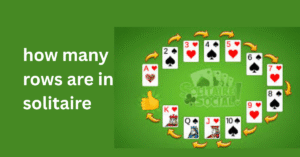Introduction
If you’ve ever found yourself lost in a cozy game of Solitaire, wondering how many rows are in Solitaire, you’re not alone! This classic card game looks simple but has a clever setup that makes every move exciting. Those neatly stacked cards aren’t random they follow a special pattern that decides how the game unfolds.
Solitaire is more than just a boredom buster; it’s a mix of logic, patience, and a little bit of luck. Whether you play on your phone or with a real deck, knowing how the rows work helps you understand the game better and win more often!
What Are the Rows in Solitaire?
Rows in Solitaire are the foundation of your game board, also known as the tableau. These rows are where all the action happens — where you build sequences, flip cards, and plan your next big move.
Each row in Solitaire holds cards that you can reveal, move, or stack based on color and value. Think of them as your puzzle pieces — the better you understand them, the smoother your game becomes.
Understanding the Tableau Layout
In Solitaire, the tableau layout is the set of seven rows (or piles) that you see at the start of the game. The first row has one card, the second has two, and this continues until the seventh row, which has seven cards. Only the top card in each row faces up; the rest stay hidden until you make a move.
This pyramid-like setup gives the game its rhythm. The layout looks simple, but every card position can change your entire strategy — that’s the fun part!
How Rows Differ from Columns and Piles
Rows, columns, piles they sound similar, right? But in Solitaire, each has its own job. Rows are laid out horizontally across the tableau, while columns and piles often refer to where cards are stacked or stored vertically.
So, while you might move a King to start a new pile, it still becomes part of a row. Understanding this small difference helps you see the board more clearly and plan smarter moves.
Importance of Rows in Gameplay Strategy
Rows are where all your strategy lives. Every move you make — revealing a hidden card or moving a sequence — happens within these rows.
The number of rows and their order decide how many cards you can uncover at once. When you manage rows well, you unlock cards faster and open up new paths to win. It’s all about balance, timing, and a bit of clever thinking.
How Many Rows Are in Solitaire?
Now, let’s answer the big question: how many rows are in Solitaire? In the classic version Klondike Solitaire — there are seven rows. Each row adds one more card than the previous, creating that satisfying staircase look.
This pattern isn’t random — it gives the game its perfect mix of challenge and playability. Seven rows create just enough complexity to keep things interesting without being overwhelming.

The Classic Klondike Solitaire Setup
In Klondike, the first row starts with one card, the second with two, and so on until you have seven rows total. Only the top card in each row is face-up, teasing you to find ways to uncover the hidden ones.
Once the tableau is ready, the remaining cards form the stockpile. From here, you draw and play cards to fill sequences in the rows or move them to the foundation piles.
Variations in Different Solitaire Versions
Not all Solitaire games follow the seven-row rule. Versions like Spider Solitaire use ten columns, while FreeCell uses eight. These variations change how the game feels and how much planning you need.
Each version tweaks the row layout for a different experience Spider adds complexity, while FreeCell offers more control. That’s the beauty of Solitaire: one rule change and it feels like a brand-new game!
Why the Number of Rows Matters
The number of rows affects how cards are distributed, how many are hidden, and how difficult your game will be. More rows mean more cards to uncover and more strategic layers to think through.
In contrast, fewer rows can make the game faster and easier. So, if you ever wondered why Solitaire feels tougher sometimes, it’s all in the layout!
How to Set Up Solitaire Rows Correctly
Getting the setup right is the key to playing fair and fun Solitaire. One small mistake — like placing an extra card in a row — can throw the whole game off balance.
If you’re playing manually, take your time during setup. If you’re online, make sure your game mode matches the classic layout for an authentic Solitaire experience.
Step-by-Step Card Arrangement
Start by laying one card face-up for the first row. Then, for each new row, place one card face-down on top of every existing pile and one face-up on the new row’s last pile. Continue until you have seven rows.
When done correctly, your tableau should have one face-up card in each row, waiting for you to make your first move. It’s simple but so satisfying to set up!
Common Mistakes to Avoid During Setup
A common error is miscounting rows or flipping too many cards face-up. Another mistake is mixing the foundation and tableau piles, which changes the gameplay entirely.
Always double-check your rows before starting. This ensures a fair challenge and keeps the game flowing smoothly.
Tips for Faster and Accurate Setup
To speed things up, lay out your rows horizontally in order and keep your deck organized. If you’re new, say the row numbers aloud as you set them. It helps avoid confusion and builds your muscle memory.
Remember, Solitaire rewards patience. Taking a few extra seconds during setup can make your game more enjoyable and less frustrating.
Different Solitaire Games and Their Row Layouts
Every version of Solitaire adds its own twist to how rows are arranged. That’s what makes each game so refreshing!
Whether you’re playing on your phone or shuffling real cards, the structure of rows changes your gameplay style and strategy every time.
Spider Solitaire Row Arrangement
Spider Solitaire is a bit more dramatic with ten columns instead of seven. All cards are placed face-down except the top card in each column.
This wider layout makes the game more challenging and strategic. You’ll need to think several moves ahead but that’s exactly what makes Spider so addictive!
FreeCell Solitaire Row Design
In FreeCell, there are eight rows and no hidden cards at all! Every card is visible from the start, turning the game into a full-on strategy puzzle.
Since nothing is hidden, every move you make has a clear consequence. It’s perfect for players who love logic and planning over pure luck.
Pyramid Solitaire and Its Unique Structure
Pyramid Solitaire lives up to its name the cards are arranged in a pyramid shape with overlapping rows. Each row supports the one above it, and you can only remove pairs of cards that add up to 13.
This version is all about smart pairing and quick math. The pyramid design keeps things light and fun, making it a favorite for casual players.
How Row Structure Affects Game Difficulty
The row structure plays a huge role in how tough your game feels. More rows often mean more hidden cards — and more surprises along the way!
Games like Spider Solitaire test your patience, while FreeCell gives you full control. The trick is to find the layout that matches your play style.
Relationship Between Rows and Strategy
Your entire Solitaire strategy revolves around how rows are placed. You’ll spend most of your time rearranging and revealing cards from these rows.
The better you understand the layout, the faster you can spot opportunities. It’s like reading a story — once you know the pattern, the ending feels closer with every move


